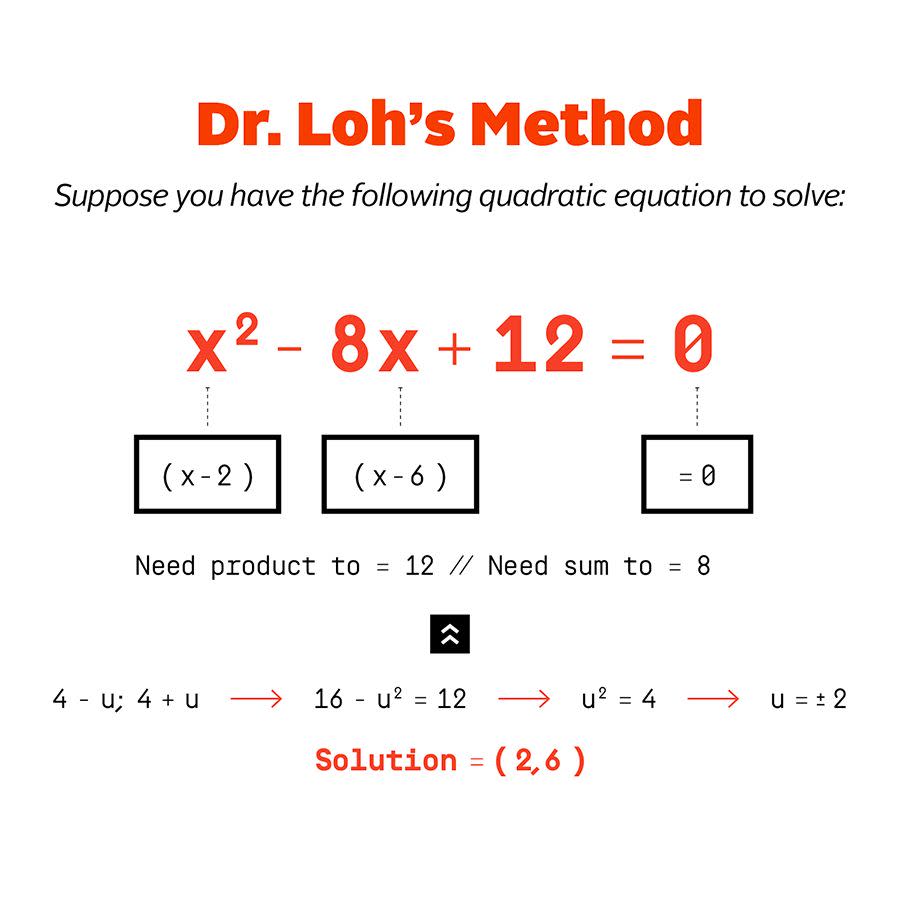This Mathematician Found an Easier Way to Solve Quadratic Equations
A mathematician at Carnegie Mellon University has developed an easier way to solve quadratic equations.
The mathematician hopes this method will help students avoid memorizing obtuse formulas.
His secret is in generalizing two roots together instead of keeping them as separate values.
A mathematician has derived an easier way to solve quadratic equation problems, according to MIT's Technology Review.
➗ You love challenging math problems. So do we. Let's solve them together.
Quadratic equations are polynomials that include an x², and teachers use them to teach students to find two solutions at once. The new process, developed by Dr. Po-Shen Loh at Carnegie Mellon University, goes around traditional methods like completing the square and turns finding roots into a simpler thing involving fewer steps that are also more intuitive.
Here's Dr. Loh's explainer video:
Quadratic equations fall into an interesting donut hole in education. Students learn them beginning in algebra or pre-algebra classes, but they’re spoonfed examples that work out very easily and with whole integer solutions. The same thing happens with the Pythagorean theorem, where in school, most examples end up solving out to Pythagorean triples, the small set of integer values that work cleanly into the Pythagorean theorem.
Quadratic equations are polynomials, meaning strings of math terms. An expression like “x + 4” is a polynomial. They can have one or many variables in any combination, and the magnitude of them is decided by what power the variables are taken to. So x + 4 is an expression describing a straight line, but (x + 4)² is a curve.
Since a line crosses just once through any particular latitude or longitude, its solution is just one value. If you have x², that means two root values, in a shape like a circle or arc that makes two crossings.

Dr. Loh’s method, which he also shared in detail on his website, uses the idea of the two roots of every quadratic equation to make a simpler way to derive those roots. He realized he could describe the two roots of a quadratic equation this way: Combined, they average out to a certain value, then there’s a value z that shows any additional unknown value. Instead of searching for two separate, different values, we’re searching for two identical values to begin with. This simplifies the arithmetic part of multiplying the formula out.

“Normally, when we do a factoring problem, we are trying to find two numbers that multiply to 12 and add to 8,” Dr. Loh said. Those two numbers are the solution to the quadratic, but it takes students a lot of time to solve for them, as they’re often using a guess-and-check approach.
Instead of starting by factoring the product, 12, Loh starts with the sum, 8.
If the two numbers we’re looking for, added together, equal 8, then they must be equidistant from their average. So the numbers can be represented as 4–u and 4+u.
When you multiply, the middle terms cancel out and you come up with the equation 16–u2 = 12. When solving for u, you’ll see that positive and negative 2 each work, and when you substitute those integers back into the equations 4–u and 4+u, you get two solutions, 2 and 6, which solve the original polynomial equation.
It’s quicker than the classic foiling method used in the quadratic formula—and there’s no guessing required. —Courtney Linder
Dr. Loh believes students can learn this method more intuitively, partly because there’s not a special, separate formula required. If students can remember some simple generalizations about roots, they can decide where to go next.
Solve These Challenging Puzzles
It’s still complicated, but it’s less complicated, especially if Dr. Loh is right that this will smooth students’s understanding of how quadratic equations work and how they fit into math. Understanding them is key to the beginning ideas of precalculus, for example.
Outside of classroom-ready examples, the quadratic method isn't simple. Real examples and applications are messy, with ugly roots made of decimals or irrational numbers. As a student, it's hard to know you've found the right answer. Dr. Loh’s new method is for real life, but he hopes it will also help students feel they understand the quadratic formula better at the same time.
Many math students struggle to move across the gulf in understanding between simple classroom examples and applying ideas themselves, and Dr. Loh wants to build them a better bridge.
Now Watch This:
You Might Also Like

